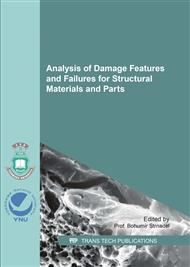p.63
p.70
p.76
p.82
p.88
p.94
p.99
p.105
p.110
Effect of Stress Ratio on Fatigue Crack Growth Threshold for Austenitic Stainless Steels in Air Environment
Abstract:
The fatigue crack growth threshold ΔKth is an important characteristic of crack growth assessment for the integrity of structural components. However, the accurate threshold ΔKth values for austenitic stainless steels in air environment are lacking in many fitness-for-service (FFS) codes, although fatigue crack growth tests have been performed and many test data had been published. This paper focuses on fatigue crack growth threshold ΔKth values for austentic stainless steel in air environment. The paper introduces the current ΔKth values provided by four major FFS codes and summarizes the available test data based on the literature survey. The paper then discusses the applicability of the existing ΔKth for stainless steels and proposes a new relation as a function of the stress ratio (the R ratio) for use by FFS codes.
Info:
Periodical:
Pages:
88-93
Citation:
Online since:
June 2017
Authors:
Price:
Сopyright:
© 2017 Trans Tech Publications Ltd. All Rights Reserved
Share:
Citation:


